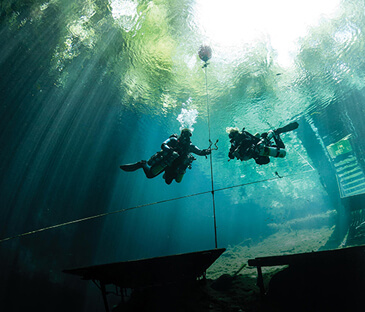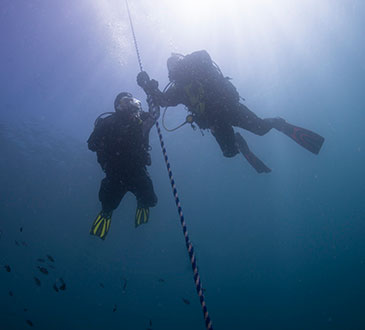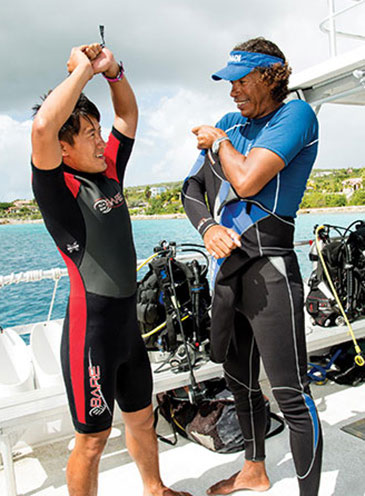Lesson 71
We will talk about the Diving Limits, what they are, and why we have them.
By the end of this section, I should be able to answer these questions:
1. What is meant by “diving within my limits”? Why is it important to do so?
2. How does failure to dive within my limits raise my risk while diving?
3. How do I expand my limits?
4. What should I do if someone subjects me to peer pressure to make a dive that is beyond my limits or that makes me uncomfortable?
Diving Within Your Limits
Whether you’re a new or experienced diver, dive within your personal limits – this means you do not exceed the limits of your training and/or experience. These limits apply to different dive environments and conditions, but also to many specialized dive activities and types of equipment. It also means you dive as you were trained, to the best of your ability.
Diving within your limits also applies to the limits of your comfort. Dives may be exciting and have some degree of challenge, but you should not have worries or any serious doubt about your ability to participate safely in the dive.
It is important to dive within your limits, because failure to do so contributes to incidents and accidents. Even if someone avoids an incident or accident when exceeding limits, the anxiety and uncertainty that result can take the fun out of the dive. Exceeding your personal limits raises your risk at least three ways.

The first is that some forms of diving have risks that may not be obvious. These require special training in recognizing and managing these risks, without which, incidents and accidents may become more likely – a diver may not know there’s a danger until it’s too late to do anything about it.
The second is that exceeding limits can cause false security. Divers may “get away with” diving beyond their limits (or having bad habits within their limits) provided nothing goes wrong. If this leads divers to think they can dive beyond their limits, they continue to do so. But the day something goes wrong, they may lack the skills and/or equipment to manage the situation and the result is an incident or accident.
The third way it raises your risk is indirectly. Some divers experience anxiety when diving outside their limits (which they should – it’s not a safe way to dive), which can cause them to focus on some concerns so much that they neglect potential problems they would normally recognize and manage appropriately. Because the diver is distracted, an incident or accident may result.

Even in the same general environment, different divers may have different limits, training and equipment requirements. For example, rebreather divers don’t typically wear snorkels for important performance reasons, and tec divers go far deeper than recreational divers. These divers do have training, equipment requirements and limits that they’re supposed to follow, but theirs differ from yours. Their gear requirements and limits do not change your gear requirements and limits.
To do more and gradually expand your personal limits as you gain experience, continue your training and dive with more experienced divers.
The PADI Advanced Open Water Diver course specifically gives you a structured path for learning new skills, trying new activities and visiting new dive sites while expanding your limits under instructor supervision. Continuing education is especially important for specialized diving like rebreather diving, or cave and other forms of tec diving, because they have unique potential hazards you have to learn to manage.
Diving with more experienced divers doesn’t replace training for activities that require it, but it does help you gradually extend your limits. For example, suppose you have local diving experience but have always been diving with 5 metre/15 foot visibility or more. It may be reasonable to dive with 2 metre/6 foot visibility with a buddy who has local experience doing so.
You also gradually extend your personal limits as you gain experience (but again, this doesn’t replace training). For example, suppose you have experience diving local sites in a wet suit, and you’re also certified as a PADI Dry Suit Diver, but all your dry suit experience is in a different environment. You can extend your personal limits by making dry suit dives at local sites, starting with dives that are well within your capabilities.
Divers should not use peer pressure to get others to make a dive they’re not comfortable with, or without equipment they know they should have. However, it does happen (not usually intentionally).
If pressured to make a dive beyond your limits or comfort, usually all you have to do is politely say “no.” You can often suggest a more conservative dive or some other adjustment that keeps you within your limits and comfort. When you explain that you have concerns, most divers will respect them. At the same time, make a point of respecting concerns other divers might have.
The rule of thumb is that if a proposed dive plan exceeds your limits, decline. That keeps the dive within your limits. If a proposed dive plan adds something that is more conservative, agree. Doing so may be necessary to keep the dive within another diver’s limits, or it may be based on a local need or practice.

For example, suppose a diver tells you that you don’t need your snorkel, you politely say that you prefer to take it with you. On the other hand, suppose an experienced local diver says that in addition to a whistle and inflatable signal tube, local divers also carry a signal mirror to attract attention. Adding a signal mirror to your kit may be prudent.
Quick quiz
Module Three

I'll take you diving!
Copyright © Larry Wedgewood Scuba Instruction All Rights Reserved

